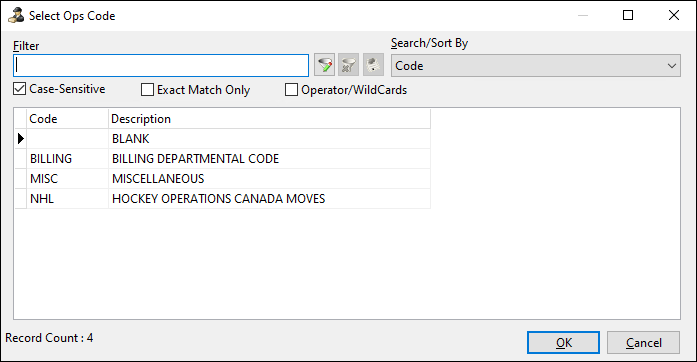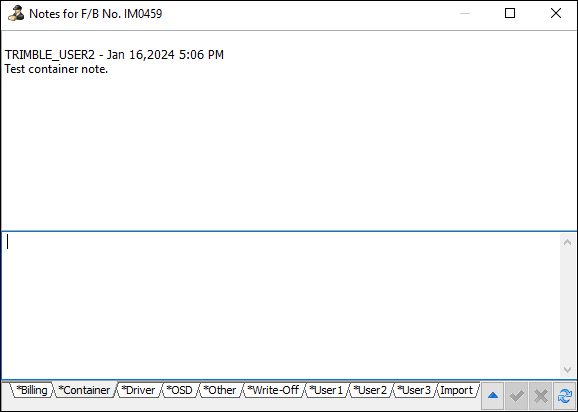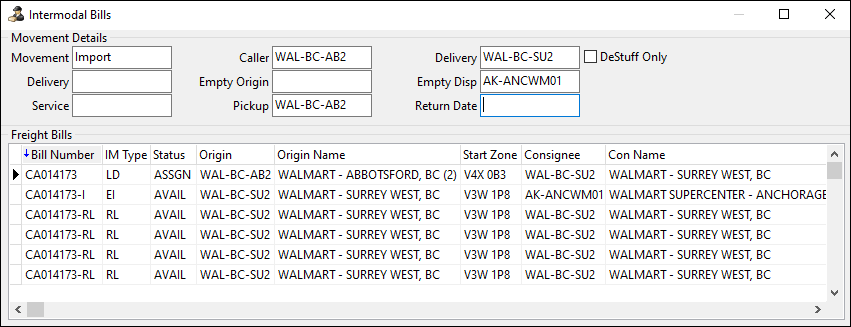Trip details section

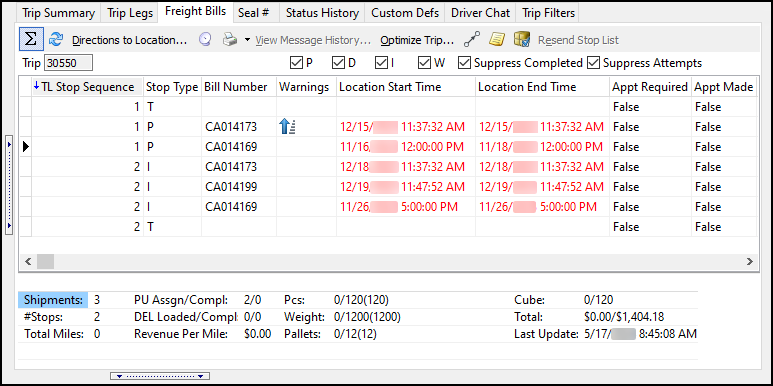
The Trip details section shows details about trips you select in the Active Trips section. It has these tabs:
-
Trip Summary
-
Trip Legs
-
Freight Bills
-
Seal #
-
Status History
-
Custom Defs
-
Driver Chat
-
Trip Filters
Special grid features
The Trip details grids have several specialty columns worth highlighting:
| Option | Definition |
|---|---|
Warnings |
Shows any warning icons that the freight bill might have. |
Late |
Indicates if the freight bill has a status with a Late behavior code. |
Active Trip |
Shows the trip number if the freight bill is on an active leg of a trip. |
Trip Summary
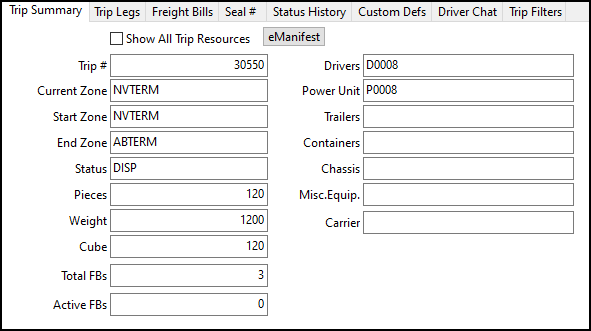
The Trip Summary tab shows details about the currently selected trip such as trip number, zone, and status.
The fields are all read-only.
Select the Show All Trip Resources checkbox to show the resources for all the legs of this trip instead of only the current leg.
Select eManifest to see if the trip number from the Trip # field has any associated manifests.
If there is only one manifest for the trip, eManifest launches to show this manifest. If there are multiple manifests for the trip, the Select Manifest window opens. Select one of the manifests to launch eManifest and display the selected manifest.
Note: This option is only enabled if CUSTOMS_LICENSE (49000) is installed.
Trip Legs
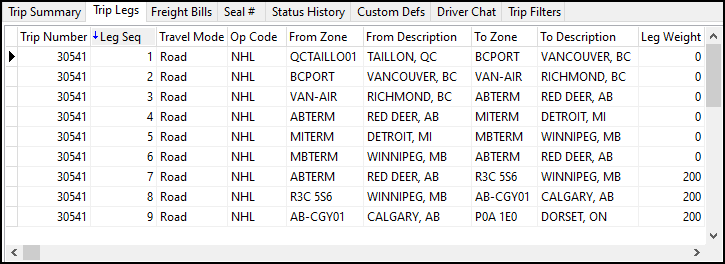
The Trip Legs tab displays details for the selected trip. Each line in this grid displays a leg sequence for that trip.
The Travel Mode column shows that leg’s mode of transit. This is particularly useful for intermodal companies.
For example, a trip might take a shipment from one terminal, to a rail yard, to another rail yard, to another terminal, and finally to an ocean liner. You can see this entire journey in the Travel Mode column.
Driver Provided ETA
The Driver Provided ETA column shows the estimated dates and times of arrival supplied by drivers. Double-click a leg in this column to open the Driver Provided ETA window.
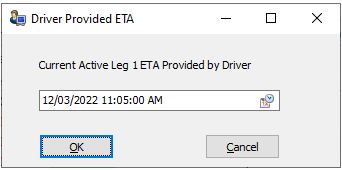
If the selected leg is active, you can add the estimated arrival date and time. If the selected leg is not active (planned or finished), you cannot enter a value in the field.
The Driver Provided ETA column is also available in most asset grids in Multi Mode Dispatch. These include drivers, power units, trailers, and so on.
In these grids, a value appears if the appropriate resource is present on a trip associated with the driver who submitted the data.
For example, on an active leg involving driver D0001, power unit P0001, and trailer TR0001, the Driver Provided ETA column value would be the same for all three resources in the respective resource grids.
The column is also visible in the Trips, P&D, Inbound, and Outbound tabs. However, it is read-only. You can only edit the value from within the Trip Legs grid.
Trip Legs shortcut menu
| Menu option | Definition |
|---|---|
Carriers |
Provides access to several carrier related functions.
|
Booking Number |
Opens the Booking Numbers window. |
Change Op Code on Leg |
Changes the Ops Code for that leg of the trip.
|
Change Op Code on Trip |
Changes the Ops Code for the trip. |
Optimize Trip |
Opens the Load Optimizer. |
Show/Hide Finished Legs |
Shows or hides completed trip legs. |
Deassign |
Removes an assigned resource from the trip. |
Mobile Messaging |
Contains several mobile messaging options. |
Reset Leg State |
Toggles the leg state between Planned and Active for the legs in a dispatched trip. |
|
Copies the details of the selected entry. |
|
Selects every record in the grid. |
|
Clears all the selected records. Hold Ctrl to select multiple records. |
Freight Bills

The Freight Bills tab shows freight bills that are assigned to the currently selected trip in the Active Trips section.
Select ![]() Toggle Summary Information to show a summary of all the freight bills for this trip at the bottom of the grid.
Toggle Summary Information to show a summary of all the freight bills for this trip at the bottom of the grid.
Stop types
This tab includes "stop types". The stop type describes the type of stop that is occurring on the move. Here are the most common stop types:
-
T (terminal)
A stop at a terminal. Certain loading and unloading actions can occur here as a result. -
W (waypoint)
A stop at a waypoint. It is the same as a terminal, with the only difference being that the zone is not marked as a "TERMINAL_ZONE". -
P (pickup)
A stop to pick up a freight bill. -
I (intermediary)
Either the pickup or drop of a freight bill at a location that is not the freight bill’s actual start zone or end zone. -
D (delivery)
A stop to deliver a freight bill.
Corrupt stops
Occasionally, it is possible to "corrupt" a freight bill’s terminal plan. One of the most common scenarios where this occurs is when a customer is changed after a bill has been assigned to a trip. This can cause the terminal plan to be recalculated, changing the bill’s associated terminal.
"Corrupt" freight bills appear in the grid, along with a stop type value in bold red letters that indicates the issue.

The most common stop type values displayed include:
-
PX
Pickup movement issue -
IX
Linehaul movement issue -
DX
Delivery movement issue -
?
Trip is no longer visible in the terminal plan
Although freight bills can still be moved in this state, Trimble strongly recommends that you review and correct these issues before the trip starts.
Freight Bills toolbar

| Menu option | Definition |
|---|---|
|
Shows or hides the summary beneath the grid. |
|
Updates the records available on the grid. |
Directions to Location |
Shows the Directions value from Customer and Vendor Profiles for the delivery client of the selected leg. |
|
Sends a Load Offer macro to the driver to review or accept. You can also send other macros or a free form message. |
|
Has options to print a variety of reports. |
View Message History |
Shows messages associated with the selected freight bill. |
Optimize Trip |
Opens the Load Optimizer. |
|
Shows any notes for the currently selected trip or freight bill.
The notes window has several of its own tabs where you can enter notes for the freight bill. The default tab is Billing tab. Select any of the other tabs to enter notes for the other categories. |
|
Shows any shipping instructions from the client for the associated freight bill. You can create shipping instructions in Codes Maintenance on the Shipping Instructions tab. You can link the instructions to specific clients on the Shipping Instructions tab of Customer Profiles. |
Resend Stop List |
Resends the stop list. Select this when you are done re-sequencing stops. A warning appears if you have not selected this before navigating away. |
Freight Bill filters

| Option | Definition | ||
|---|---|---|---|
P (Pickups) |
Filters the grid by pickup-type bills. |
||
D (Deliveries) |
Filters the grid by delivery-type bills. |
||
I (Interliner) |
Filters the grid by interliner probill-type bills. |
||
W (WayPoints) |
Displays or hides WayPoints so you can plan terminal-to-terminal trips. |
||
Suppress Completed |
Hides any freight bills with a Completed status. |
||
Suppress Attempts |
Hides any freight bills with attempts pick or delivery statuses, such P01, P02, D01, or D02. Attempted/missed picks and deliveries are status codes. They are assigned specific rules in Codes Maintenance > Status > Additional Rules. These statuses are for situations where the shipper arrives at a terminal but the freight is not available for pick or delivery.
|
Freight Bills shortcut menu
| Menu option | Definition |
|---|---|
Toggle Design Mode |
Activates the Screen Design mode to create and save different layouts. For more information, see Custom Screen Design Mode and Screen Design tab. |
Select All |
Selects every record displayed in the grid. |
Clear Selection |
Clears any selected records. |
Full Screen |
Expands this grid to fill the whole screen view. |
Unmatch Bill(s) |
Un-matches bills from a planned trip, putting the bills back to their original status before they were matched to a trip. |
Reassign Bill(s) |
Reassigns a freight bill from one trip or trap to another.
|
Directions to Location |
Shows the Directions value from Customer and Vendor Profiles for the delivery client of the selected leg. |
Change Status |
Changes the freight bill’s status. The status codes available are defined in the Status Codes tab in Codes Maintenance. If you change the bill’s status to Finish Unloading, and it is the last bill on the last leg of the trip, TruckMate may ask if you are finished with the trip. If you select No, TruckMate will add an empty leg to the trip and change the trip’s status to DISPATCH. Set the app config Trip Status after Stopoff Leg to None. |
Freight Bill Notes |
Shows any notes for the currently selected trip or freight bill. |
View Custom Defined Fields |
Opens the Custom Defined Fields window to display and information entered into any custom fields. |
|
Shows any shipping instructions from the client for the freight bill. |
|
Changes the freight bill’s end zone. |
|
When working with "pick" door bills, select this option to set the shipment to the Direct status. |
Freight Bill Routing Plan |
Opens the Routing window to:
|
Set Via Zone |
Adds a via zone to the current trip. |
Adjust Delivery Date - Late Pickup |
Updates the order by:
This option is only available if the SLM Calculate Delivery After Save config option is set to True. Note: This option will not work if a delivery appointment is set, a late pickup is already set, or a delivery date cannot be calculated. |
Update Stop Sequence |
Refreshes the stop sequence order for the legs to reflect recent changes. |
Update Freight Bill(s) |
Refreshes the freight bill’s information to reflect recent changes. |
Optimize Trip |
Opens the Load Optimizer. |
Mobile Messaging |
Contains several mobile messaging options. |
View Intermodal Destuff FBs |
Shows all the intermodal freight bills linked to an intermodal movement.
This feature is disabled for all freight bills except for loaded intermodal freight bills. |
Barcode Item Details |
Opens the Trip Item Details window where you can add, delete, and view barcode information. |
Failed PARS Processing |
Marks the freight bill as having failed Pre-Arrival Review System (PARS) processing. If the Canadian customs CCN (Cargo Control Number) Type is PARS, the Failed PARS process starts to update the Manifest From/To and Location of Goods fields. It also starts to generate new cargo control numbers. PARS allows Customs Brokers to submit shipment release information given by the importer and carrier to the Canada Border Services Agency (CBSA) for review and processing before the goods arrive in Canada. |
Dangerous Goods Details |
Right-click a freight bill and select this option to view any dangerous goods for that freight bill. |
Seal #

The Seal # tab provides details about the selected trip’s seal activity. The grid is read-only except for the Seal Numbers field. This lets you edit seal numbers that are not linked to a status change.
The only shortcut menu option unique to this tab is Edit Seal Numbers. This opens the Seal Numbers window which can be used to edit the seal number information and break seals.
Custom Defs

The Custom Defs tab shows custom defined field information for the currently selected trip.
Custom Defined fields are created on the Custom Defined Fields tab in Codes Maintenance.
Driver Chat
The Driver Chat tab displays any chat text created by a mobile device associated with this trip.
For a trip with a mobile device, a message text window is available to allow a dispatcher to send messages to the device.
The message is sent and displayed in the Message Center program when the mobile communication service is running.
If there is no mobile device assigned to the trip, or if the driver does not have mobile account, the message text window would not be available and a warning message is displayed.
